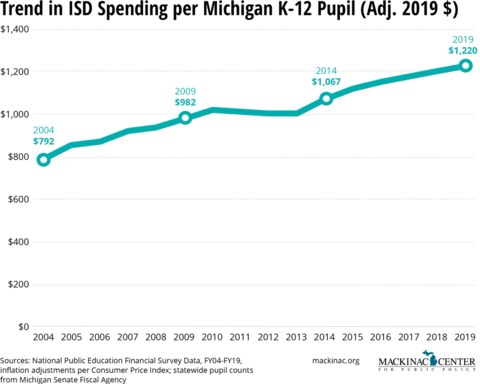Commentary
Now is the Time to Start Downsizing ISDs
Education bureaucracies should take brunt of looming budget hit

PxHere
When a parent loses hours and pay at work, the family may have to revisit the household budget and ask what spending items can be cut back or done away with altogether. It can be a painful opportunity to reassess priorities.
Michigan’s school funding systems are more complex than a household budget, with many streams of funding and moving parts. But a similar reality is fast approaching for Lansing lawmakers. Less tax money will be available this year and next to fund the state’s public schools. Rather than cutting local agencies across the board, though, officials should look first to scale back the state’s 56 intermediate school districts.
In the economic crisis accompanying the COVID-19 pandemic, these regional bureaucracies, with their heavy reliance on local property taxes, are on more stable fiscal ground than school districts and public charter schools. For local school districts, state funding plays a larger role. And charters, which disproportionately serve more low-income students, have no access to local property tax dollars at all.
The current structure is neither essential nor universal, as 15 states have no regional educational agencies. Meanwhile, Michigan’s ISDs have no contact with most students. Instead, they coordinate the state’s poorly rated special education services and operate career education centers, administer state funding to local preschool programs and provide various back-office services for local school districts.
Yet while Michigan’s public school enrollment has fallen by more than 14% since 2004, the footprint of ISDs has continued to grow. Adjusted for inflation, these agencies’ operating budgets and payrolls are both over 32% larger than 15 years earlier. These figures do not include state and federal dollars passed through the ISD to local schools and other program operators.

While ISDs accounted for 1 in every 16 dollars spent on Michigan K-12 education in 2004, by 2019, that figure was very nearly 1 in 10. If ISDs spent the same share of K-12 funds as they did in 2004, more than $650 million would be shifted to districts and charter schools, which operate closer to students and manage classrooms. That’s significantly more than the emergency federal education funding coming to help ease the budget cuts many local Michigan districts and charters will face due to revenues curtailed by the pandemic.
Among the options state lawmakers can take to reduce spending in this year’s budget would be to withhold the final three payments designated for ISD general operations funding. The $18.9 million savings for the state would hold back just over 1% of these agencies’ combined annual budgets.
Students, teachers and classrooms need not bear the brunt of COVID-19’s looming fiscal impacts, which means withholding the final three payments of the year should not be the end to cutting back on intermediate school districts. It’s time to dramatically downsize the bureaucratic footprint in Michigan public education.
|

Now is the Time to Start Downsizing ISDs
Education bureaucracies should take brunt of looming budget hit
When a parent loses hours and pay at work, the family may have to revisit the household budget and ask what spending items can be cut back or done away with altogether. It can be a painful opportunity to reassess priorities.
Michigan’s school funding systems are more complex than a household budget, with many streams of funding and moving parts. But a similar reality is fast approaching for Lansing lawmakers. Less tax money will be available this year and next to fund the state’s public schools. Rather than cutting local agencies across the board, though, officials should look first to scale back the state’s 56 intermediate school districts.
In the economic crisis accompanying the COVID-19 pandemic, these regional bureaucracies, with their heavy reliance on local property taxes, are on more stable fiscal ground than school districts and public charter schools. For local school districts, state funding plays a larger role. And charters, which disproportionately serve more low-income students, have no access to local property tax dollars at all.
The current structure is neither essential nor universal, as 15 states have no regional educational agencies. Meanwhile, Michigan’s ISDs have no contact with most students. Instead, they coordinate the state’s poorly rated special education services and operate career education centers, administer state funding to local preschool programs and provide various back-office services for local school districts.
Yet while Michigan’s public school enrollment has fallen by more than 14% since 2004, the footprint of ISDs has continued to grow. Adjusted for inflation, these agencies’ operating budgets and payrolls are both over 32% larger than 15 years earlier. These figures do not include state and federal dollars passed through the ISD to local schools and other program operators.
While ISDs accounted for 1 in every 16 dollars spent on Michigan K-12 education in 2004, by 2019, that figure was very nearly 1 in 10. If ISDs spent the same share of K-12 funds as they did in 2004, more than $650 million would be shifted to districts and charter schools, which operate closer to students and manage classrooms. That’s significantly more than the emergency federal education funding coming to help ease the budget cuts many local Michigan districts and charters will face due to revenues curtailed by the pandemic.
Among the options state lawmakers can take to reduce spending in this year’s budget would be to withhold the final three payments designated for ISD general operations funding. The $18.9 million savings for the state would hold back just over 1% of these agencies’ combined annual budgets.
Students, teachers and classrooms need not bear the brunt of COVID-19’s looming fiscal impacts, which means withholding the final three payments of the year should not be the end to cutting back on intermediate school districts. It’s time to dramatically downsize the bureaucratic footprint in Michigan public education.
Michigan Capitol Confidential is the news source produced by the Mackinac Center for Public Policy. Michigan Capitol Confidential reports with a free-market news perspective.
More From CapCon